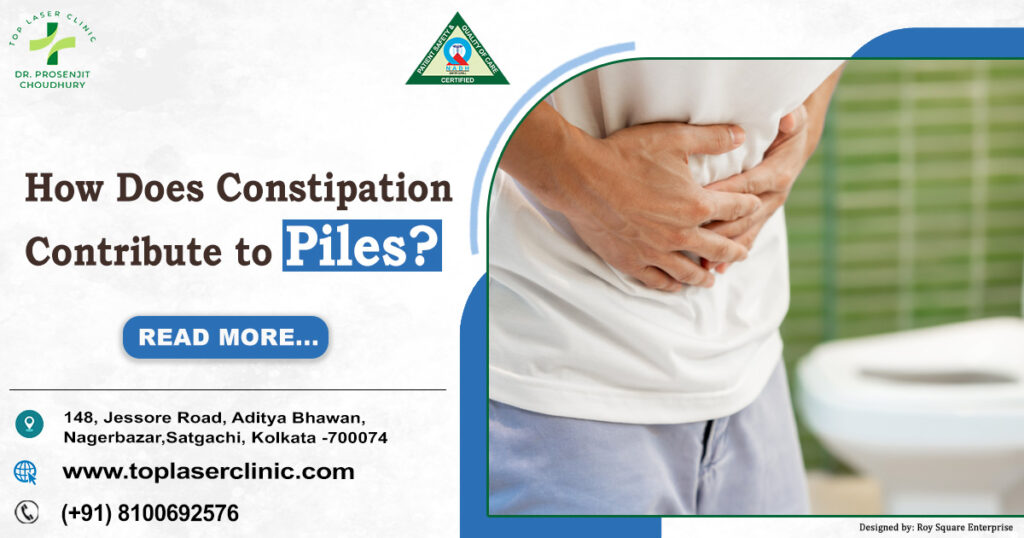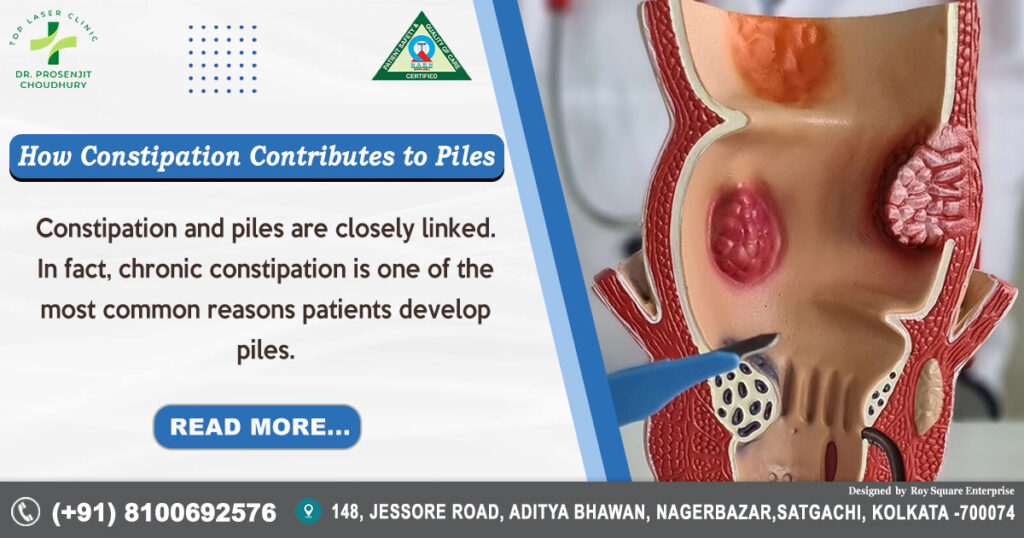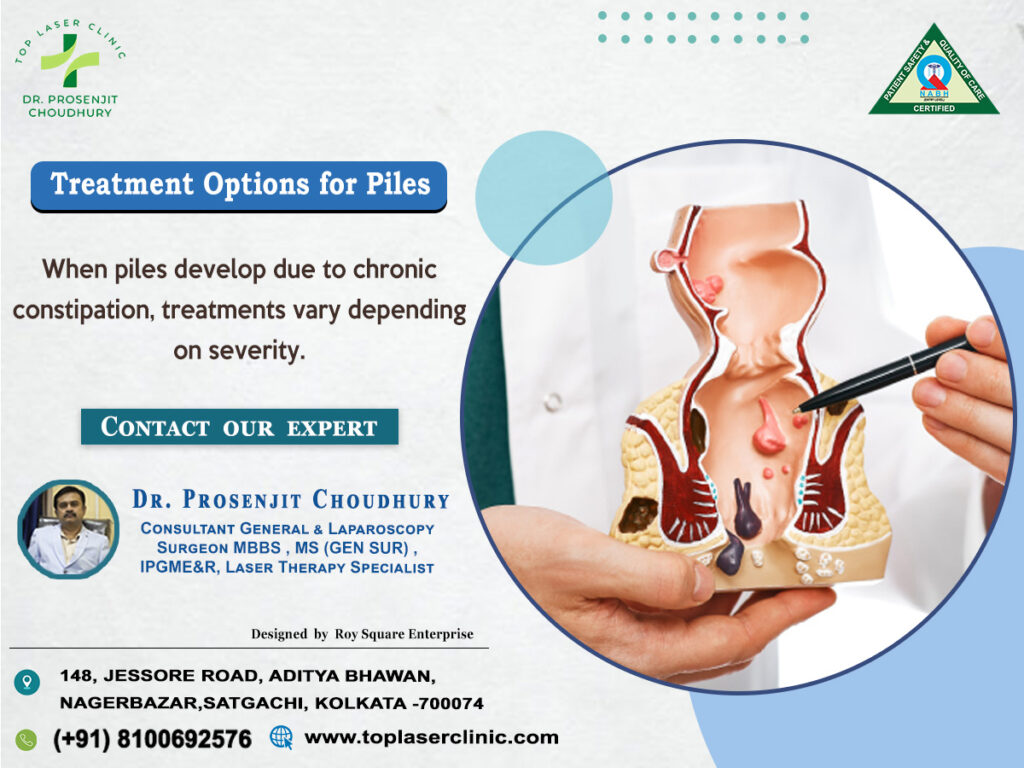
Piles, also known as haemorrhoids, are among the most common health problems people face worldwide. They are often painful, embarrassing, and can significantly affect a person’s quality of life. While there are many factors that contribute to the development of piles, chronic constipation remains one of the leading causes.
Understanding how constipation leads to piles is important, not just for treatment but also for prevention. To shed light on this topic, we’ve included insights from Dr. Prosenjit Choudhury, Consultant General & Laparoscopy Surgeon, MBBS, MS (Gen Surg), IPGME&R, and Laser Therapy Specialist at Top Laser Clinic. With years of expertise in treating piles using modern surgical and laser techniques, Dr. Choudhury emphasizes that early intervention and lifestyle modifications can prevent mild constipation from turning into a severe piles condition.
What Are Piles?
Piles are swollen and inflamed veins in the rectum or anus that cause discomfort, pain, itching, and sometimes bleeding during bowel movements. They can be:
- Internal Piles – Located inside the rectum, usually painless but may bleed.
- External Piles – Found under the skin around the anus, often painful and itchy.
Most cases of haemorrhoids are related to increased pressure in the rectal veins, which is commonly caused by constipation and straining during bowel movements.
What Is Constipation?
Constipation refers to a condition where bowel movements are infrequent, difficult, or incomplete. Typically, fewer than three bowel movements per week is considered constipation. Symptoms include:
- Hard or dry stools
- Straining during bowel movements
- Feeling of incomplete evacuation
- Abdominal discomfort or bloating
How Constipation Contributes to Piles

Constipation and piles are closely linked. In fact, chronic constipation is one of the most common reasons patients develop piles. Here’s how it happens:
1. Straining During Bowel Movements
When you are constipated, stools become hard and difficult to pass. This forces you to strain while sitting on the toilet. Straining puts immense pressure on the rectal veins, causing them to swell and form piles.
2. Hard Stools Injure Rectal Lining
Dry, hard stools can cause tiny tears in the anal lining. These tears increase irritation and inflammation, worsening haemorrhoids symptoms and sometimes causing anal fissures.
3. Increased Pressure in Rectal Veins
Prolonged constipation keeps the rectal veins under constant pressure. Over time, these veins lose elasticity, leading to permanent swelling and pile formation.
4. Delayed Bowel Movements
When people with constipation avoid or delay bowel movements, stools sit longer in the colon, absorbing more water and becoming harder. This further worsens constipation and piles—a vicious cycle.
5. Long Toilet Sitting
Many people with constipation spend a long time in the toilet, waiting for stools to pass. This sitting position increases pressure in the rectum, encouraging piles to develop.
Dr. Prosenjit Choudhury explains:
“Constipation is not just about discomfort. It is one of the leading culprits behind piles. Patients who ignore constipation for months or years often end up with advanced haemorrhoids requiring surgical or laser intervention. Early treatment of constipation can prevent piles altogether.”
Symptoms of Piles Caused by Constipation
If constipation is not managed, it often leads to the following piles symptoms:
- Painful bowel movements
- Bleeding during or after passing stools
- Swelling or lumps near the anus
- Persistent itching or irritation in the anal area
- Mucus discharge
- Feeling of incomplete evacuation
Why Chronic Constipation Must Not Be Ignored
Constipation may seem like a minor issue, but when chronic, it becomes a major risk factor for piles and other complications such as:
- Anal fissures (painful cracks in anal skin)
- Rectal prolapse (part of rectum slips out of anus)
- Fistula in ano (abnormal tract near anus)
- Increased risk of strangulated haemorrhoids (cut off blood supply)
This is why doctors like Dr. Prosenjit Choudhury stress that constipation is not to be ignored, but to be treated seriously with lifestyle changes and medical intervention if necessary.
Who Is at Risk?
Certain groups of people are more likely to suffer from constipation and, therefore, haemorrhoids:
- Office workers with sedentary lifestyles
- People with low-fiber diets
- Individuals who do not drink enough water
- Pregnant women (due to hormonal changes and pressure on intestines)
- Elderly (slower bowel movements with age)
- People on certain medications (painkillers, iron supplements, antidepressants)
How to Prevent Constipation and Piles
1. Eat a High-Fiber Diet
Fiber softens stools and promotes smooth bowel movement. Include:
- Whole grains, brown rice, oats
- Fruits like apples, pears, papaya
- Vegetables like spinach, carrots, beans
- Legumes and lentils
2. Drink Plenty of Water
At least 8–10 glasses daily helps soften stools and prevents dehydration-related constipation.
3. Exercise Regularly
Physical activity improves bowel movement. Even 20–30 minutes of walking daily helps.
4. Avoid Straining
Go to the toilet when you feel the urge. Avoid forcing bowel movements.
5. Limit Processed Foods
Reduce intake of refined flour, fried foods, and excess sugar, which slow digestion.
6. Establish a Routine
Try to maintain a fixed toilet schedule, ideally in the morning after breakfast.
7. Don’t Delay Nature’s Call
Holding stools makes constipation worse and increases piles risk.
Treatment Options for Piles

When haemorrhoids develop due to chronic constipation, treatments vary depending on severity.
1. Home Remedies & Lifestyle Changes
- Warm sitz baths to relieve pain
- High-fiber diet & hydration
- Over-the-counter creams or ointments
2. Medications
- Stool softeners and laxatives (only under doctor’s supervision)
- Pain relievers and anti-inflammatory medicines
3. Non-Surgical Treatments
- Rubber band ligation
- Sclerotherapy (injection treatment)
- Infrared coagulation
4. Laser Treatment for haemorrhoids
Laser surgery is a modern, minimally invasive technique. It offers:
- Less pain
- Minimal bleeding
- Quick recovery
- Short hospital stay
Dr. Prosenjit Choudhury, being a Laser Therapy Specialist at Top Laser Clinic, highlights:
“Laser treatment has revolutionized piles surgery. Unlike conventional surgery, it is less invasive, causes minimal discomfort, and patients can resume normal life much faster. For patients with chronic constipation-induced piles, laser surgery is one of the safest and most effective options today.”
FAQs About Constipation and Piles
1. Can constipation alone cause piles?
Yes. Chronic constipation is one of the most common causes of haemorrhoids.
2. Will treating constipation cure piles?
In early stages, yes. But advanced piles may require medical or surgical intervention.
3. Are piles permanent?
Mild haemorrhoids may resolve with lifestyle changes. Severe cases may require surgery.
4. Do piles always bleed?
Not always. Some haemorrhoids cause pain and swelling without bleeding.
5. Is laser piles surgery safe?
Yes, it is safe, minimally invasive, and offers quicker recovery compared to conventional methods.
Final Thoughts
Constipation is not just an uncomfortable inconvenience—it is one of the leading causes of piles, a condition that can cause significant pain and distress. By maintaining healthy bowel habits, eating a fiber-rich diet, staying hydrated, and seeking timely medical advice, one can prevent constipation from progressing into haemorrhoids.
As Dr. Prosenjit Choudhury, Consultant General & Laparoscopy Surgeon and Laser Therapy Specialist at Top Laser Clinic, advises:
“Ignoring constipation is like ignoring a ticking time bomb. Early management can save patients from piles and their complications. And for those who already suffer from piles, advanced treatments like laser surgery offer a safe, effective, and quick recovery solution.”
By adopting preventive strategies and seeking expert care when needed, it is possible to break the constipation–piles cycle and lead a healthier, more comfortable life.
Top 10 FAQs: How Constipation Contributes to Piles
1. Can constipation really cause piles?
Yes. Chronic constipation is one of the leading causes of piles. Straining to pass hard stools increases pressure on rectal veins, leading to swelling and haemorrhoids.
2. How do I know if my piles are due to constipation?
If you have a history of hard stools, infrequent bowel movements, and straining along with symptoms like pain, bleeding, or swelling in the anus, constipation is likely the root cause.
3. Will treating constipation cure piles?
In early stages, improving bowel habits can reduce or even cure piles. But if piles have advanced, you may still need medical or surgical treatment.
4. What foods should I eat to prevent constipation and piles?
A fiber-rich diet is best: whole grains, fruits (papaya, apple, banana), vegetables (spinach, carrots, beans), and legumes. Drink plenty of water.
5. What foods should I avoid if I have constipation and piles?
Limit refined flour, fried food, junk food, excessive meat, and low-fiber diets. These make stools harder and worsen constipation.
6. Can piles heal on their own if constipation is corrected?
Mild piles may shrink with lifestyle changes, but moderate to severe piles often require medical procedures such as laser treatment.
7. How can I prevent constipation-related piles?
- Eat fiber-rich food
- Drink 8–10 glasses of water daily
- Exercise regularly
- Don’t ignore the urge to pass stools
- Avoid sitting on the toilet for too long
8. When should I see a doctor for piles?
If you have severe pain, heavy bleeding, a lump near the anus, or constipation lasting more than a few weeks, consult a specialist like Dr. Prosenjit Choudhury at Top Laser Clinic.
9. Is laser treatment safe for constipation-induced piles?
Yes. Laser piles surgery is safe, minimally invasive, and offers quick recovery with less pain and minimal bleeding.
10. Can constipation and piles return after treatment?
Yes, if poor habits continue. Without long-term dietary and lifestyle changes, constipation can recur and trigger piles again.